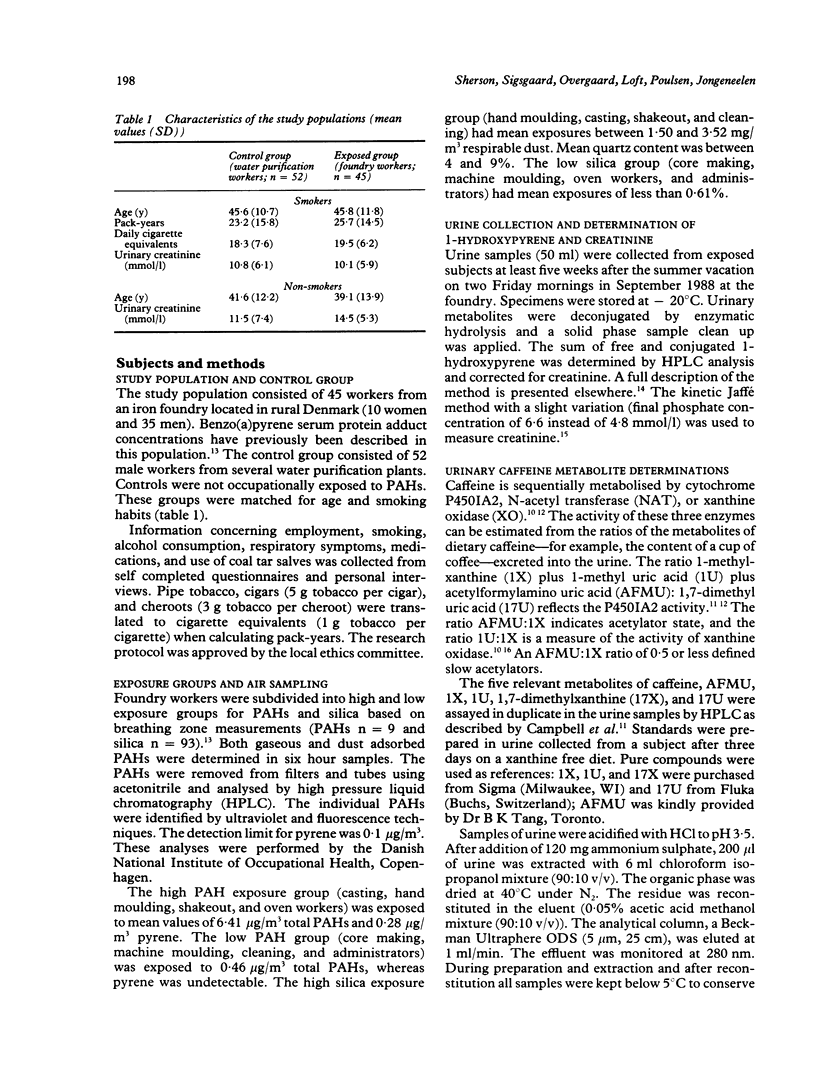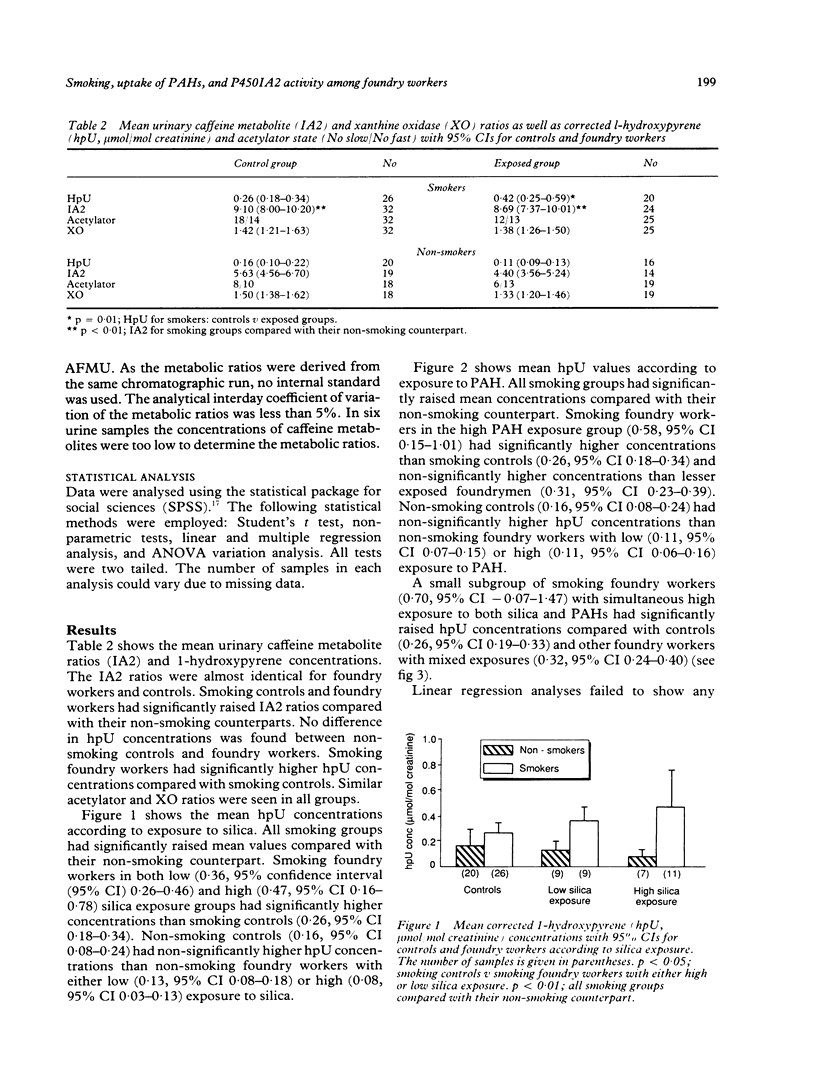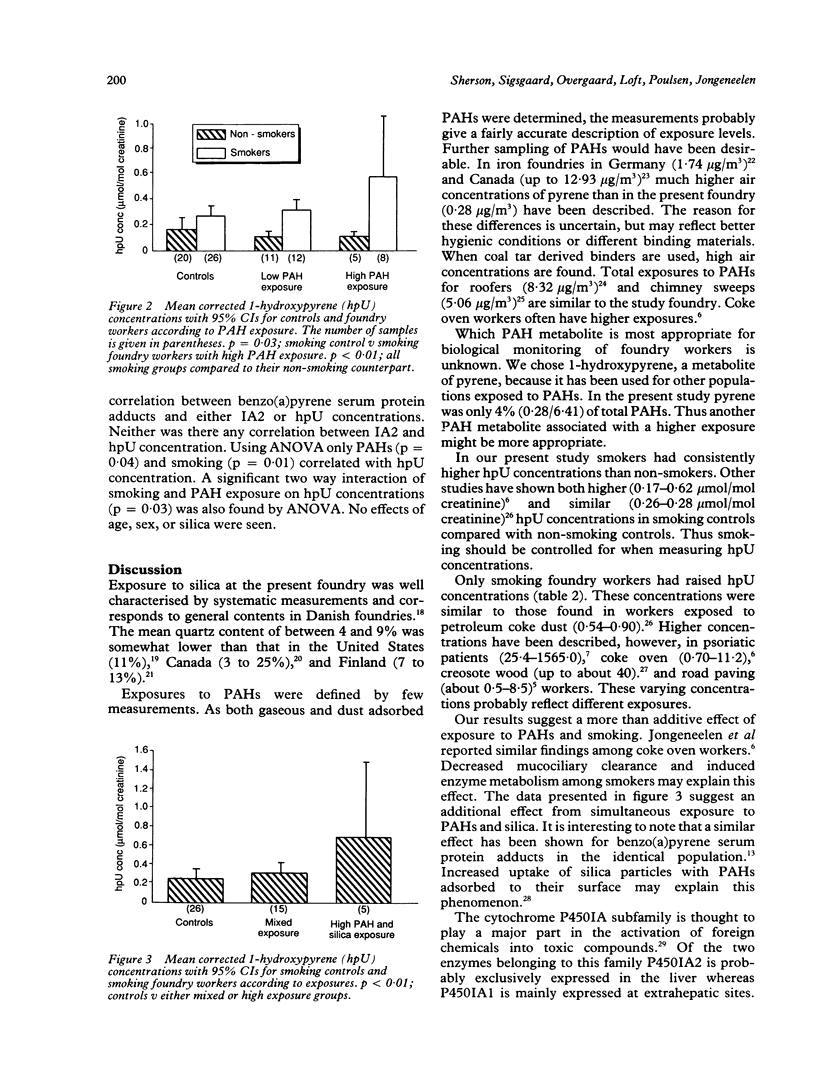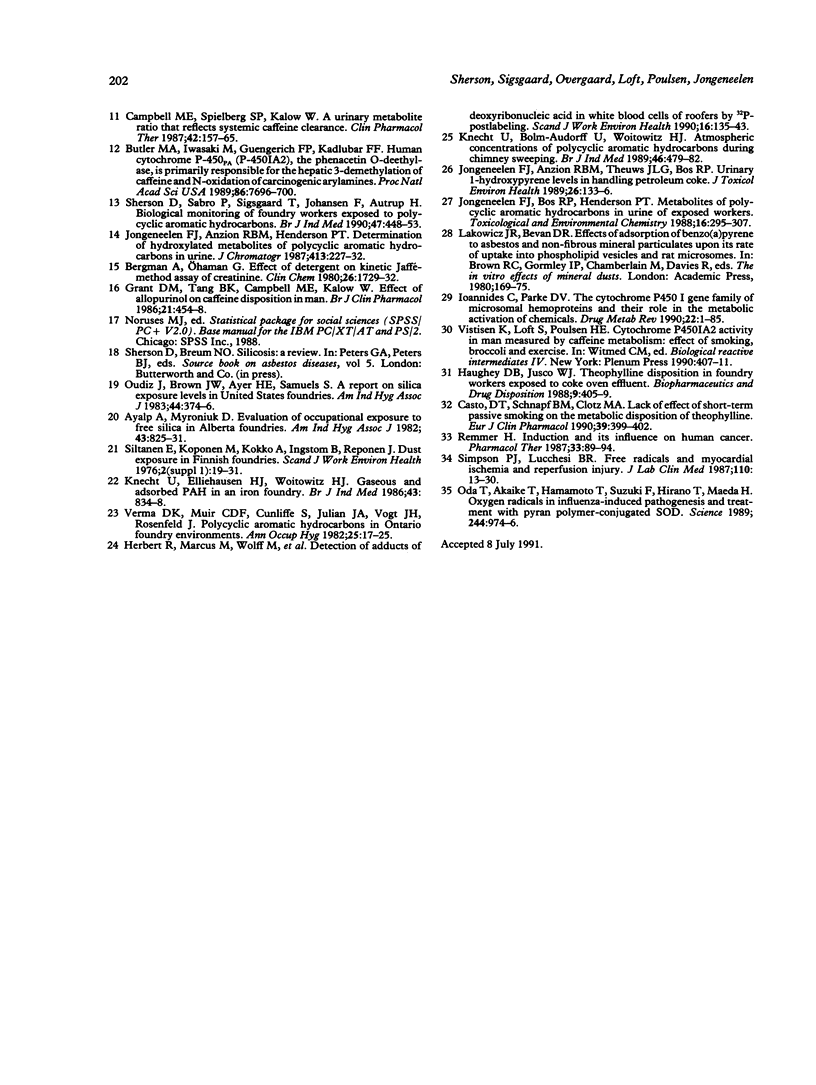Abstract
An increased lung cancer risk has been described among foundry workers. Polycyclic aromatic hydrocarbons (PAHs) and silica are possible aetiological factors. This study describes a urinary PAH metabolite, 1-hydroxypyrene (hpU), as well as the degree of cytochrome P450IA2 activity/induction as reflected by the urinary caffeine ratio (IA2) in 45 foundry workers and 52 controls; IA2 was defined as the ratio of paraxanthine 7-demethylation products to a paraxanthine 8-hydroxylation product (1,7-dimethyluric acid). Mean exposure concentrations for foundry workers were defined by breathing zone hygienic samples (respirable dust 1.2 to 3.52 mg/m3 (93 samples)) and as total PAH (0.46 micrograms/m3) and pyrene concentrations (0.28 micrograms/m3) (six samples). Non-smoking controls and foundry workers had similar IA2 ratios (5.63, 95% confidence interval (95% CI) 4.56-6.70 and 4.40, 95% CI 3.56-5.24). The same was true for smoking controls and foundry workers (9.10, 95% CI 8.00-10.20 and 8.69, 95% CI 7.37-10.01). Both smoking groups had raised IA2 ratios compared with non-smokers (p less than 0.01). Non-smoking controls and foundry workers had similar hpU concentrations (0.16, 95% CI 0.10-0.22 and 0.11, 95% CI 0.09-0.13 mumol/mol creatinine). Smoking foundry workers had raised hpU concentrations (0.42, 95% CI 0.25-0.59) compared with smoking controls (0.26, 95% CI 0.18-0.34) (p less than 0.01). A small subgroup of smoking foundry workers with the highest exposures to both silica and PAH also had the highest hpU concentrations (0.70, 95% CI - 0.07-1.47 mumol/mol creatinine) (p less than 0.04). Increased hpU concentrations in smoking foundry workers suggest a more than additive effect from smoking and foundry exposures resulting in increased PAH uptake. Increased P450IA2 enzyme activity was only found in smokers and no additional effect of foundry exposures was seen. These data suggest that smoking as well as work related PAH exposure may be casually related to increased risk of lung cancer in foundry workers.
Full text
PDF





Selected References
These references are in PubMed. This may not be the complete list of references from this article.
- Ayalp A., Myroniuk D. Evaluation of occupational exposure to free silica in Alberta foundries. Am Ind Hyg Assoc J. 1982 Nov;43(11):825–831. doi: 10.1080/15298668291410648. [DOI] [PubMed] [Google Scholar]
- Bergman A., Ohman G. Effect of detergent on kinetic Jaffé-method assay of creatinine. Clin Chem. 1980 Nov;26(12):1729–1732. [PubMed] [Google Scholar]
- Butler M. A., Iwasaki M., Guengerich F. P., Kadlubar F. F. Human cytochrome P-450PA (P-450IA2), the phenacetin O-deethylase, is primarily responsible for the hepatic 3-demethylation of caffeine and N-oxidation of carcinogenic arylamines. Proc Natl Acad Sci U S A. 1989 Oct;86(20):7696–7700. doi: 10.1073/pnas.86.20.7696. [DOI] [PMC free article] [PubMed] [Google Scholar]
- Campbell M. E., Spielberg S. P., Kalow W. A urinary metabolite ratio that reflects systemic caffeine clearance. Clin Pharmacol Ther. 1987 Aug;42(2):157–165. doi: 10.1038/clpt.1987.126. [DOI] [PubMed] [Google Scholar]
- Casto D. T., Schnapf B. M., Clotz M. A. Lack of effect of short-term passive smoking on the metabolic disposition of theophylline. Eur J Clin Pharmacol. 1990;39(4):399–402. doi: 10.1007/BF00315418. [DOI] [PubMed] [Google Scholar]
- Clonfero E., Zordan M., Venier P., Paleologo M., Levis A. G., Cottica D., Pozzoli L., Jongeneelen F. J., Bos R. P., Anzion R. B. Biological monitoring of human exposure to coal tar. Urinary excretion of total polycyclic aromatic hydrocarbons, 1-hydroxypyrene and mutagens in psoriatic patients. Int Arch Occup Environ Health. 1989;61(6):363–368. doi: 10.1007/BF00381025. [DOI] [PubMed] [Google Scholar]
- Fletcher A. C., Ades A. Lung cancer mortality in a cohort of English foundry workers. Scand J Work Environ Health. 1984 Feb;10(1):7–16. doi: 10.5271/sjweh.2361. [DOI] [PubMed] [Google Scholar]
- Grant D. M., Tang B. K., Campbell M. E., Kalow W. Effect of allopurinol on caffeine disposition in man. Br J Clin Pharmacol. 1986 Apr;21(4):454–458. doi: 10.1111/j.1365-2125.1986.tb05222.x. [DOI] [PMC free article] [PubMed] [Google Scholar]
- Grant D. M., Tang B. K., Kalow W. Variability in caffeine metabolism. Clin Pharmacol Ther. 1983 May;33(5):591–602. doi: 10.1038/clpt.1983.80. [DOI] [PubMed] [Google Scholar]
- Guengerich F. P. Roles of cytochrome P-450 enzymes in chemical carcinogenesis and cancer chemotherapy. Cancer Res. 1988 Jun 1;48(11):2946–2954. [PubMed] [Google Scholar]
- Haughey D. B., Jusko W. J. Theophylline disposition in foundry workers exposed to coke oven effluent. Biopharm Drug Dispos. 1988 Jul-Aug;9(4):405–409. doi: 10.1002/bod.2510090409. [DOI] [PubMed] [Google Scholar]
- Herbert R., Marcus M., Wolff M. S., Perera F. P., Andrews L., Godbold J. H., Rivera M., Stefanidis M., Lu X. Q., Landrigan P. J. Detection of adducts of deoxyribonucleic acid in white blood cells of roofers by 32P-postlabeling. Relationship of adduct levels to measures of exposure to polycyclic aromatic hydrocarbons. Scand J Work Environ Health. 1990 Apr;16(2):135–143. doi: 10.5271/sjweh.1806. [DOI] [PubMed] [Google Scholar]
- Ioannides C., Parke D. V. The cytochrome P450 I gene family of microsomal hemoproteins and their role in the metabolic activation of chemicals. Drug Metab Rev. 1990;22(1):1–85. doi: 10.3109/03602539008991444. [DOI] [PubMed] [Google Scholar]
- Jongeneelen F. J., Anzion R. B., Henderson P. T. Determination of hydroxylated metabolites of polycyclic aromatic hydrocarbons in urine. J Chromatogr. 1987 Jan 23;413:227–232. doi: 10.1016/0378-4347(87)80230-x. [DOI] [PubMed] [Google Scholar]
- Jongeneelen F. J., Anzion R. B., Theuws J. L., Bos R. P. Urinary 1-hydroxypyrene levels in workers handling petroleum coke. J Toxicol Environ Health. 1989;26(1):133–136. doi: 10.1080/15287398909531238. [DOI] [PubMed] [Google Scholar]
- Jongeneelen F. J., Scheepers P. T., Groenendijk A., Van Aerts L. A., Anzion R. B., Bos R. P., Veenstra S. J. Airborne concentrations, skin contamination, and urinary metabolite excretion of polycyclic aromatic hydrocarbons among paving workers exposed to coal tar derived road tars. Am Ind Hyg Assoc J. 1988 Dec;49(12):600–607. doi: 10.1080/15298668891380312. [DOI] [PubMed] [Google Scholar]
- Jongeneelen F. J., van Leeuwen F. E., Oosterink S., Anzion R. B., van der Loop F., Bos R. P., van Veen H. G. Ambient and biological monitoring of cokeoven workers: determinants of the internal dose of polycyclic aromatic hydrocarbons. Br J Ind Med. 1990 Jul;47(7):454–461. doi: 10.1136/oem.47.7.454. [DOI] [PMC free article] [PubMed] [Google Scholar]
- Knecht U., Bolm-Audorff U., Woitowitz H. J. Atmospheric concentrations of polycyclic aromatic hydrocarbons during chimney sweeping. Br J Ind Med. 1989 Jul;46(7):479–482. doi: 10.1136/oem.46.7.479. [DOI] [PMC free article] [PubMed] [Google Scholar]
- Knecht U., Elliehausen H. J., Woitowitz H. J. Gaseous and adsorbed PAH in an iron foundry. Br J Ind Med. 1986 Dec;43(12):834–838. doi: 10.1136/oem.43.12.834. [DOI] [PMC free article] [PubMed] [Google Scholar]
- Oda T., Akaike T., Hamamoto T., Suzuki F., Hirano T., Maeda H. Oxygen radicals in influenza-induced pathogenesis and treatment with pyran polymer-conjugated SOD. Science. 1989 May 26;244(4907):974–976. doi: 10.1126/science.2543070. [DOI] [PubMed] [Google Scholar]
- Oudiz J., Brown J. W., Ayer H. E., Samuels S. A report on silica exposure levels in United States foundries. Am Ind Hyg Assoc J. 1983 May;44(5):374–376. doi: 10.1080/15298668391404996. [DOI] [PubMed] [Google Scholar]
- Remmer H. Induction and its influence of human cancer. Pharmacol Ther. 1987;33(1):89–94. doi: 10.1016/0163-7258(87)90034-9. [DOI] [PubMed] [Google Scholar]
- Sesardic D., Boobis A. R., Edwards R. J., Davies D. S. A form of cytochrome P450 in man, orthologous to form d in the rat, catalyses the O-deethylation of phenacetin and is inducible by cigarette smoking. Br J Clin Pharmacol. 1988 Oct;26(4):363–372. doi: 10.1111/j.1365-2125.1988.tb03393.x. [DOI] [PMC free article] [PubMed] [Google Scholar]
- Sherson D., Sabro P., Sigsgaard T., Johansen F., Autrup H. Biological monitoring of foundry workers exposed to polycyclic aromatic hydrocarbons. Br J Ind Med. 1990 Jul;47(7):448–453. doi: 10.1136/oem.47.7.448. [DOI] [PMC free article] [PubMed] [Google Scholar]
- Sherson D., Svane O., Lynge E. Cancer incidence among foundry workers in Denmark. Arch Environ Health. 1991 Mar-Apr;46(2):75–81. doi: 10.1080/00039896.1991.9937432. [DOI] [PubMed] [Google Scholar]
- Siltanen E., Koponen M., Kokko A., Engström B., Reponen J. Dust exposure in Finnish foundries. Scand J Work Environ Health. 1976;2 (Suppl 1):19–31. doi: 10.5271/sjweh.2838. [DOI] [PubMed] [Google Scholar]
- Silverstein M., Maizlish N., Park R., Silverstein B., Brodsky L., Mirer F. Mortality among ferrous foundry workers. Am J Ind Med. 1986;10(1):27–43. doi: 10.1002/ajim.4700100105. [DOI] [PubMed] [Google Scholar]
- Simpson P. J., Lucchesi B. R. Free radicals and myocardial ischemia and reperfusion injury. J Lab Clin Med. 1987 Jul;110(1):13–30. [PubMed] [Google Scholar]
- Verma D. K., Muir D. C., Cunliffe S., Julian J. A., Vogt J. H., Rosenfeld J., Chovil A. Polycyclic aromatic hydrocarbons in Ontario foundry environments. Ann Occup Hyg. 1982;25(1):17–25. doi: 10.1093/annhyg/25.1.17. [DOI] [PubMed] [Google Scholar]


